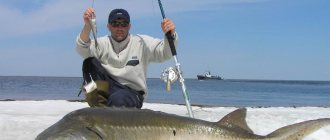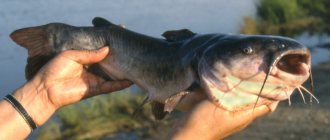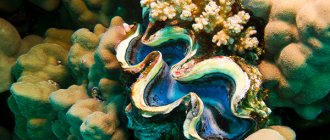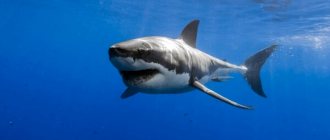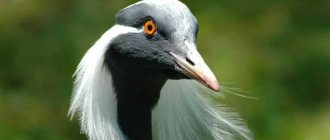A few years ago, Thursday in Russia was a fish day.
Nowadays, sea fish is on dinner tables almost every day. This can be easily explained by the variety of its types. We'll look at them below. Most often you
- Do it yourself 64%, 51 votes
51 votes 64%51 votes - 64% of all votes
- Buy ready-made sprats 25%, 20 votes
20 votes 25%
20 votes - 25% of all votes
- I don't eat fish 11%, 9 votes
9 votes 11%
9 votes - 11% of all votes
Total votes: 80
06.02.2020
- Do it yourself 64%, 51 votes
51 votes 64%51 votes - 64% of all votes
- Buy ready-made sprats 25%, 20 votes
20 votes 25%
20 votes - 25% of all votes
- I don't eat fish 11%, 9 votes
9 votes 11%
9 votes - 11% of all votes
Total votes: 80
06.02.2020
×
You or from your IP have already voted.
Where did fish come from?
- The first known ancient fish-like creatures did not have jaws.
- Then, in the course of evolution, jaws formed from the gill arch and jawed fish appeared, which existed together with jawless fish for more than 100 million years.
- About 400 million years ago, cartilaginous fish appeared. Modern representatives of cartilaginous species (about 1000 species in total) are sharks and rays.
- Following the cartilaginous fish, bony fish developed - lobe-finned and ray-finned (they make up 95% of modern fish).
- The lobe-finned species include lungfishes that have both gill and pulmonary respiration. Of the ancient lungfishes, only the horn-toothed ones (found in Australia and Africa) have survived.
Hornteeth
Modern lobe-fins are also represented by lobe-fins from the coelacanth family - they are considered living fossils, the structure of their skeleton remains the same as it was hundreds of millions of years ago. Moreover, the fins of the coelacanth are more reminiscent of the limbs of a frog.
Thus, one branch from the common ancestor of fish gave rise to modern fish, while the other may have been forced to adapt to life on land as a result of the drainage of water bodies. It is assumed that ancient fish with developed muscles at the base of the fins and with double breathing are the ancestors of the first amphibians, from which the evolution of vertebrates went further.
Coelacanth
When did fish appear?
Lobe-finned fish
It is believed that the first ancestors of modern fish began to appear about 400 million years ago. In the process of evolution, they were divided into two main groups: ray-finned and lobe-finned.
A characteristic feature of ray-finned fish was the appearance of paired fins and a swim bladder, due to which they acquired a streamlined shape and the ability to swim well, and they had gills. From this group are mainly derived the species of fish known today.
Lobe-finned fish lived in fresh water bodies and had powerful fins with rounded blades.
The end of the Devonian period was marked by climate change. Many reservoirs dried up, which forced the lobe-finned species to adapt to the new environment. During evolution, they first develop jaws, then the swim bladder transforms into lungs, and the ability to move with the help of fins appears. Millions of years during which they adapted to changing living conditions made these creatures unique and very beautiful.
Structure of fish
Fish are aquatic vertebrates that live in bodies of sea and fresh water. They have gill respiration to absorb oxygen dissolved in water and a body structure adapted to life in an aquatic environment.
The characteristic features of fish are gills and fins. Some have adapted to do without fins (lamrey), and are also able to additionally breathe atmospheric air (amphibian fish, for example, umbra).
Pisces are usually bisexual. Some fish species have pronounced sexual dimorphism. In this case, it is possible to distinguish females from males by various anatomical features, for example, by the shape of the body and fins. Sexual dimorphism in fish becomes more pronounced during the breeding season.
Internal structure
Fish swim with the help of muscles, which are divided into slow and fast.
- Slow ones are intensely red in color, contain a large amount of myoglobin, do not get tired for a long time and are responsible for long monotonous swimming.
- Fast muscles are powerful, white - used for jerking.
In addition to movement, muscles perform other functions. In some cold-water fish, muscle activity ensures thermoregulation (tuna), and these are the beginnings of warm-bloodedness. The modified muscles of electric stingrays and eels act as an electric battery.
Internal structure of fish
The basis of the fish skeleton is the spine, in the canal of which the spinal cord passes. The ribs extend from the vertebrae. The fins of bony species are formed by bony rays with a membrane. The bones of the skull are mobile, which allows the jaws to work more actively.
The brain is small in size, but quite well developed.
The inner ear is responsible for hearing; fish do not have an eardrum or actual ears.
The mechanism of respiration in fish is as follows:
- Water enters the mouth, then it is pushed through the gills. In this case, the blood is enriched with oxygen in the gill filaments and enters all tissues.
- The heart pumps venous blood back to the gills.
Antarctic fish have no hemoglobin in their blood, which is why, for example, icefish have colorless blood.
Circulatory system of fish
Digestive system of bony fish:
- mouth opening with one or more rows of teeth;
- pharynx;
- short esophagus;
- stomach (absent in cyprinids);
- pancreas;
- intestines;
- liver.
Food is processed by enzymes in the stomach and enters the intestines. Fish that feed primarily on plant foods have longer intestines than those of predators.
The excretory system of fish is represented by gills and kidneys with a bladder and ureter.
Fish face a serious problem with osmoregulation. Marine species with lower (relative to ambient) osmotic pressure constantly lose water from their bodies and must drink heavily to avoid dehydration. This is best done in cartilaginous species (sharks), in which the osmotic pressure inside the body practically corresponds to the pressure of sea water.
- Excess salts in marine life come out through the kidneys, gills, and intestines. Less urine is produced compared to freshwater.
- In freshwater, the situation is the opposite - the surrounding water is constantly absorbed into the body due to the higher concentration of salts inside the body, that is, it is deliberately too much to drink. In such a situation, the osmotic pressure is equalized by the active removal of water by the kidneys.
Freshwater gills are adapted to actively absorb salts. Restoration of salt balance also occurs with food. Perhaps this is why the inhabitants of fresh water bodies love salty feeding.
Differences in the absorption and excretion of salt in freshwater and marine fish
Gonads - paired testes in males, which are also called milt, and single or paired ovaries in females.
Caviar is an egg with a nutritious yolk in a protective shell, sometimes sticky for attachment to the surface. In viviparous fish, males have a copulatory organ for internal fertilization.
Most fish have a swim bladder to regulate their weight. It is also needed as an air reservoir and can act as a barometer and hearing amplifier.
External structure
There are 3 sections (main) in the body of fish:
- head;
- torso;
- tail part.
External structure of fish
The shape of the mouth is determined by the type of food:
- in fish that feed from the surface, the mouth is directed upward;
- in bottom fish, the upper jaw is longer, the mouth is directed downward, which allows them to take food from the bottom.
The mouth opening is framed by lips; some have antennae (organs of touch) located near the mouth. In the mouth, as well as on the gills, antennae, and even on the surface of the body, there are receptors responsible for taste.
Olfactory receptors are located in the nostrils. The sense of smell is more developed in fish whose sense of smell is actively involved.
In most fish, the eyes are located on the sides, with each eye forming a separate visual picture; in front, these pictures overlap by only 20-30%. This feature of vision does not allow accurate estimation of distance. The visual acuity of most fish is limited to a few meters, depending on the lighting and cleanliness of the water. At the same time, sharks have vision even sharper than that of humans due to a more intense interaction of the retinal receptors with light.
To increase the field of vision, some fish have bulging eyes. The field of vision is also expanded by a specific white spot on the ocular surface - a pearly organ that is connected to the retina.
It is worth noting that some fish manage without vision, orienting themselves in space using the lateral line.
The body shape of fish depends on the living conditions; it can be torpedo-shaped and spherical, eel-shaped and sail-shaped with fins developed in height. Various combinations of shapes are often found.
Fins are divided into paired (pectoral, abdominal) and unpaired (anal, caudal, adipose, dorsal). Paired fins are necessary for fish to level their position and maneuver when turning. The dorsal and anal serve as a keel for stability. There may be one, two (perciformes), or three (cod) dorsal fins. The body ends with the caudal fin - this is the main part of the fish’s body, responsible for movement.
Most fish are covered with scales, although some species do not have scales. Scales are a protective covering of bone plates. Skin pigment cells are responsible for different colors.
The skin also contains glands that produce a mucous secretion for better gliding in water and for protection against pathogens.
On the body of fish there is a kind of sensory organ - the lateral line, which runs in a straight line along the entire body. The lateral line is a subcutaneous canal with sensitive cells whose receptors perceive water vibrations.
The device of the lateral line of fish
Units
Belonging to a squad is one of the classification characteristics. Squads are included in classes. The latter may include several units. There are also categories such as subfamilies, superorders, etc.
Sturgeon
This is an order of ray-finned fish, part of the subclass of cartilaginous ganoids. This includes sturgeon and paddlefish. They are detected only in the Northern Hemisphere and are concentrated in numerous forms on the territory of Russia. These are Russian and Sakhalin sturgeon, thorns, stellate sturgeon, sterlet, etc.
Herring
These are primitive bony representatives from the order ray-finned. Typical pelagic fish of Russia, which can be freshwater or marine. The list includes European alose, puzankas, herring, sprat, sprat, etc.
Salmonidae
These are also ray-finned fish, which are combined into a single salmon family. The fish here are varied in size (medium and large sizes are found). Here we meet lenok, pink salmon, chum salmon, chinook salmon, sockeye salmon, coho salmon, salmon, etc. They all have reddish fatty meat.
Salmon family
This includes three subfamilies (salmon, whitefish and grayling) with varieties of fish in each of these categories. Grayling is the least numerous. There is a single genus of Grayling with three representatives.
Subfamily Salmonidae
This subfamily includes a list of 8 genera: lenka, taimen, Pacific salmon, Sakhalin taimen, Far Eastern trout, salmon, char, longfin palia. They all have specific, similar characteristics. In the northern hemisphere, they live only in fresh water. Large spawning grounds in the natural environment are located in Kamchatka, Sakhalin, and the Kuril Islands.
Subfamily Whitefish
Otherwise, these are Belorybitsy or Nelma. There are fewer incoming births here. There are only three of them: whitefish, whitefish, and whitefish. They prefer fresh water, which is why they love Russian rivers: Pechora, Northern Dvina, Ob. They also live in some lakes.
Smelt-like
They belong to the order of ray-finned fish. These are bony representatives that spawn in freshwater environments. Growing up, they move to live in the seas and oceans in the temperate climate zone. The most famous edible representatives are smelt and capelin. These are all small fish with a thin body.
Smelts
In the Northern Hemisphere (including Russia) they are found in seas and freshwater environments. These are important representatives for the fishery. In appearance, they are easily distinguished by their elongated body and not very large size, as well as their silver color.
Pike-like
Ray-finned fish, which includes 2 families and 12 species of fish. They are related to salmonids (they are part of the same order). They are found in northern Eurasian fresh water, which ensures catching in Russia.
Pike
This family includes 3 genera with 9 species. The body of such fish is elongated, with a large mouth on an elongated stigma. The most famous representatives are pikes. This also includes the lineage of Novumbra and Dahlia. They are found everywhere in Russia in fresh water bodies.
Umber
There are 7 species classified into three genera. In Russia they are found in the Danube and numerous Siberian rivers. Closer to Chukotka the number increases. They are considered hardy. These are medium-sized fish, but with a short stigma, unlike the previous ones.
Eels
Ray-finned fish, including representatives with a serpentine body shape. Their specificity lies in the method of movement - crawling and swimming with bending of the body occurs like a snake. The amplitude running through the carcass during movement is constant. With the standard form, this amplitude increases in other fish.
Family River eels
This includes 19 species and all of them are suitable for consumption. The length can be even 2 meters. In Russia they are found in the Baltic Sea basin, in rivers and lakes from the basins of the Azov, Black, White, Barents and Caspian seas. They are also found in other reservoirs of the European part of Russia.
Carp-like
This order includes a large mass of all freshwater representatives of the ray-finned class. They make up 15% of all bony fish. Their length varies from one centimeter to three meters. They are of great importance for fishing.
Carp
Found in large numbers in the temperate zone of the Northern Hemisphere. Very hardy and prolific. For fishing, roach, bream, carp, crucian carp, tench, ide, etc. are of greatest importance here. Living and dead food of plant or animal origin is acceptable for them to eat.
Chukuchanovs
The description visually resembles cyprinids. The encyclopedia lists approximately 8 dozen species in this family. In Russia there are common Chukuchan and North American ones: buffalo smallmouth, largemouth and black. Most of them are found in Kolyma.
Balitoriaceae
All members of the family are bottom-dwelling freshwater fish. The mustachioed loach, which is part of this family, is widespread in Russia. It can be found in reservoirs of Siberia and the Far East, as well as in the Pskov region.
Loaches
They live in numerous bodies of fresh water in Eurasia. There are 177 different species, grouped into 26 genera and a couple of subfamilies. These are small fish with an elongated body and unremarkable coloring. They prefer muddy bodies of water to live in. Their appearance slightly repels them, because... there is a resemblance to a reptile. The common loach, common in Russia, also has one. There is no mass fishing here, although the meat of such fish is tasty.
Order Catfish
It includes about 4 dozen families, 500 genera and approximately 4000 species. There are 10 species in fresh Russian waters. They vary in length. This parameter starts from 1.2 cm and reaches several meters and several hundred kilograms. But most of them are still represented by small fish up to 10 cm.
Catfish
Large representatives living in Russia (mainly the common catfish), which reach a length of several meters. The record is 5 meters. They are found in the bottom areas of water bodies. There are approximately 100 species, grouped into 12 genera. These fish of Russia are all bottom-dwelling and widely distributed in the Eurasian part.
Orcas
They are distinguished by a long fin on their back. The body is the same as in the previous case, elongated without scales and covered with mucus (sometimes poisonous). The border of the range in the North includes the Amur River basin. They have a medium body size and bare skin. As a standard, like all catfishes, they have antennae.
Ictaluraceae
Not very common in Russia. American catfish is found in the western regions. Reproduction in reservoirs with warm waste water from state district power plants and thermal power plants is possible after importation or their accidental entry here. It is also bred artificially in farms near Moscow.
Garfish
This order includes only one family living in Russia - Adrianichthyaceae. The rest are distributed throughout the world and differ from our species. They have an elongated body and jaws. Most of the representatives are marine species. They live in coastal areas and in open ocean waters. They are located in the surface layers. Only a third of species live in brackish and fresh water bodies. They are of great importance for fishing.
Adrianichthyaceae
In turn, this family includes only the genus Orisia. The only representative of the genus called “medaka” is found in the Krasnodar region due to the suitable climate. In appearance it is very different from other representatives of the order. It has an absolutely standard and unremarkable body shape, as well as silver-colored scales.
Cyprinodontiformes
This includes more than 1,200 species of fish. All of them are small in size and live in fresh water. Many of them are brightly colored. Based on these criteria, they are often chosen for breeding in aquariums. They resemble cyprinids in appearance, but are smaller in size. They also differ in the description of the structure of the jaw. Here the presence of teeth is revealed.
Poeciliaceae
There are approximately three hundred small viviparous species of fish in this family. They mainly live in fresh water and only a few are found in brackish and sea water. They choose different bodies of water based on size: from large to small lakes and quiet streams. But there are also turbulent passing channels.
Codfish
Member of the ray-finned order. In size, specimens range from a couple of centimeters to two meters. The location of the ventral fins on the body is similar to perciformes. And in terms of the general structure of all fins, they are cypriniform. These are mainly marine species, but there are also freshwater species. In total, there are 13 families, 84 genera and 613 species of fish.
Burbot
Burbots are distinguished by their love of fresh water. The rest of the order prefer salt water. They have an elongated body and a wide head. They are found in the Baltic, White, Barents, Black and Caspian seas, in Siberian rivers, Baikal, Yenisei, etc.
cod
“Central” representatives of the detachment in question. There are 4 subfamilies, 20 genera and 56 species. They are found in fresh and salt water in the northern hemisphere. But besides the Burbot, all other representatives live in the sea. Therefore, they cannot be found in closed reservoirs and they are rarely found in migratory rivers. The most famous genera are cod, pollock, blue whiting, navaga, and haddock.
Sticklebacks
They are included in the superorder spinyfin. Depending on the species, there are representatives of different lengths: from several to two tens of centimeters. The encyclopedia lists 11 families included in different superfamilies and suborders. There is still controversy regarding the classification of all representatives.
Sticklebacks
They belong to the suborder Sticklebacks. There are 18 species that love fresh, brackish and salt water. A distinctive feature is the presence of a spine in front of the dorsal fin. They are not valuable for fishing and it is difficult for other fish to get along with them in the same body of water, since they are excessively voracious.
Order Acicularis
Includes several families. The more famous is the needle family. They are distinguished by their elongated and “thin” body shape, which explains the meaning of the name. They also look like a tube with a mouth at the end. In Russia, only needles are found.
Needle
Or otherwise needle fish. The family includes more than 180 species and 11 of them are found in Russian waters. There are many of them in the Black Sea. Moreover, in Russia, fish are found even in the water column, although they mainly prefer shallow water and shelter in the form of algae. Males have a pouch on their abdomen for rearing young.
Order Perciformes
They are not picky and can live in the marine environment and in most freshwater bodies throughout the planet and in all climatic zones. They are valuable as commercial fish. They are distinguished by a great variety of representatives with different body sizes and colors.
Percoidei
This is a family of ray-finned representatives that live in fresh and brackish waters. The common genus of perches included here are then pike perches and ruffs. All of them are distributed throughout Northern Europe. Chops and sculpin perches, as well as percarines, are found exclusively in the Black and Azov Sea basin. Teeth and sometimes fangs grow on the jaw. There are transverse stripes along the body.
Percikhtidae
There are 34 species, grouped into 11 genera. Can reach 1.8 meters. Some species included here are under threat of extinction. In Russia they are distributed in the Amur River basin, in Lake Khanka and in the north-west of Sakhalin. Externally they have a standard appearance of perches, but are distinguished by a wide variety of colors.
Centrarchae
Otherwise called eared perches. There are up to 45 species, united in 9 genera. Distributed mainly in fresh water in North America. In Russia they are found in the Black Sea basin. Due to their bright colors and iridescent scales, they are characterized as sunfish.
Perch
In the Black and Azov Seas, chops, sculpins and perkarins are common. They have a standard appearance and size for perciformes. They are a kind of standard for all representatives of the squad. Here the structure and color that are standard for perches (including stripes on the body) are revealed. The family is represented by 236 species, grouped into 9 genera and 5 subfamilies.
Cichlids
Or cichlids. About 1,300 species fit this classification. Many are important commercial fish. Some are regarded as valuable for breeding in aquariums: sklaria, discus, oscar. Mozambian tilapia and eight-banded cichlid are found in Krasnodar reservoirs. The first spread, entering the natural environment from fish farms, and the second from aquariums.
Order Gobiiformes
These are gobiformes. Includes more than 300 genera and more than 2000 species. Representatives of the order live in freshwater and seawater. Dimensions vary from approximately 8 mm to 50 cm. They inhabit the seas with warm water that wash Russia: Black, Azov, Caspian. The most famous representative is the goby, which is actively caught and supplied as food to the population. They are prolific, so their numbers replenish quickly.
Goloveshkovye
They are also called odontobutaceae. The family includes 6 genera and 21 species. The species M.cinctus is common in Russia. It can be found in the Amur, Ussuri, Zeya river basins, as well as in Lake Khanka. During their life they migrate between freshwater and sea waters. Another species - Goloveshka - is also found in small lakes, swamps, and creeks of the Amur. They live their entire lives in fresh water.
Gobies
There are about 1300 species here. They are united into approximately 190 genera. They are divided into two groups: brackish water and marine. The first are relics that have lived in the Black Sea basin since the emergence of a communication channel with the Caspian Sea. They are also found in the Dniester and Dnieper. The second are immigrants from the Mediterranean to the Black Sea.
Order Anabantiformes
Slide-shaped. There are about 250 species, all of which are freshwater. They have an additional respiratory organ. Not relict for Russian waters. Rarely seen. Available in Primorsky Krai.
Snakeheads
In Russia you can find the snakehead, a freshwater predatory fish that sometimes reaches impressive sizes (up to a meter and 10 kg). It is caught in the Amur, Ussuri, Razdolnaya rivers and in lakes Khasan and Khanka. They have a large head, like a snake, which explains the presence of such a name. From the photo you can see their terrifying appearance, but a person’s excessive fear of such fish is not justified.
Scorpiformes
There are 7 suborders included here, 26 families, 280 genera and approximately 1,500 species. Found in seawater and freshwater. One of the representatives of the order (Pseudoliparis amblystomopsis) is considered the deepest-sea fish in nature, because. representatives are found at depths of up to 7.7 kilometers.
Kerchakovs
Otherwise called slingshots. There are about 200 species and 60 genera. They are distinguished by their large and flattened head compared to the body. Most of the species of the family are marine, living close to the shore, on the bottom. They are found mainly in the Gulf of Finland.
Golomyankovye
Perhaps the most interesting fish of Lake Baikal (as you can see from the photo) are representatives of the family such as the Golomyanka genus. Endemic to this body of water. They are pelagic representatives, always living in the water column. 35% composed of fat. They are viviparous.
Classification of river fish species
According to the type of food, predatory and peaceful fish are divided.
- Peaceful lake and river fish feed on plant foods, as well as invertebrates. Freshwater fish with a peaceful nature do not hunt their relatives. There are exclusively herbivores (silver carp). There are also omnivorous fish (carp) - euryphages that consume both plant and animal food without significant preferences.
- Predators hunt for other fish, or for young animals of their own species, and also attack birds and mammals. At the same time, predators can diversify their diet with invertebrates.
Many species begin their feeding on plankton, then move on to eating invertebrates and other fish.
Which one is sold in stores?
If you live far from the sea coast, and fresh sea fish is offered at the market or supermarket, then you definitely need to think carefully. There is a high probability that simple river fish, a defrosted semi-finished product, will be sold. Each region of the country has its own fishery, or even several, from which fish can be supplied to local supermarkets. Sellers must have an official certificate. He will confirm the information regarding the fish supplied. Before purchasing seafood, always try to carefully study this issue. This will avoid many difficulties in the future.
When buying fish in a store aquarium, the main thing you should pay attention to is the purity of the water. Ideally, the fish should swim in the lowest part of the aquarium, where all the healthy, most active representatives of the water element always live.
If you notice that the fish moves little, is lethargic, and is already swimming upside down, then you should refuse to purchase it.
Predatory fish
The main diet of predators consists of smaller fish. Predators attack quickly (with the exception of catfish), have an excellent appetite during a meal, and sometimes swallow fish larger than themselves. A hungry pike or perch, the most common predatory fish in Russia, can behave this way. There are also semi-predators that periodically feed on the young of other fish, but such food is not their main food.
Bersh
Volga pike perch (bersh) from the perch family. It is found in rivers flowing into the seas in southern Russia. It grows in length over 40 cm, weighing up to 3 kg. Outwardly, this predatory river fish resembles a pike perch or a very large ruff. Unlike pike perch, it has no fangs. Stays in a pack. It feeds mainly on the young of other fish.
Bersh
Goby
A bottom-dwelling species of fish of the goby family, with a wide head and large eyes. The pelvic fins are fused into a sucker, with the help of which the goby is able to stay on the bottom. The marine species is native to the Mediterranean Sea and cannot live in fresh water. The brackish-water species is found in coastal areas in the Black Sea, as well as in the Caspian and Azov Seas. Distributed in the Dnieper and Volga. Usually small in size, up to 20 cm, weighing up to 200 g. It feeds mainly on mollusks, less often crustaceans, worms and fish fry. Can eat plant foods.
Goby
Chub
Semi-predatory schooling fish of the carp family. Cunning and cautious, with a fighting character. Length - up to 80 cm, weight - up to 8 kg. The chub got its name because of its wide head. These river fish are found in rivers with fairly fast currents, sometimes in the vicinity of trout and grayling. It feeds on both algae and invertebrates, falling insects, frogs, and fish. The chub rarely hunts for fry, which is why it has received the status of a semi-predator.
Chub
Char
Commercial fish of the salmon family. Arctic char is the ancestral form of all char. Migratory char during the spawning period is a fish with red fins and an orange-red belly. It feeds on juveniles of other fish, crustaceans, and insect larvae.
Char
Ruff
A bottom-dwelling small fish of the perciform family. On the back of the ruffe there are sharp spines on the front part of the fused dorsal fin, the punctures of which should be avoided. It feeds mainly on crustaceans, but can also catch fry. It is caught all year round in its camp sites. More often you come across specimens up to 200 g. Used for catching pike. In the Danube River there is a species listed in the Red Book of Ukraine - the Balona ruff.
Cod family
All representatives, with the exception of burbot, are marine inhabitants. Small species feed on plankton, while large fish are predators. Cod have delicious dietary meat. Fat during fattening primarily accumulates in the liver rather than in muscle tissue.
Atlantic cod
Found in temperate latitudes of the Atlantic, it does not enter warm waters. The length of an adult individual can reach 180 cm, and weight – 50 kg; For commercial purposes, individuals with a length of 40 to 80 cm are used. The fish spends most of its life at depth, moving to shallow water only during the spawning period. Cod feed on fry, shrimp and juveniles. The species is of great commercial importance.
Burbot
The fish is common in northern rivers and lakes of Europe and Asia. Burbot eats and spawns in the cold season, and in warm water falls into torpor. The length of the body can exceed a meter, and the weight can reach 18 kg. Juveniles eat dragonflies, crustaceans and fish eggs. Adults eat carp, small salmon, and perch. The burbot fishery has a beneficial effect on populations of other fish species.
Haddock
A bottom-dwelling fish that lives in the northern regions of the Atlantic Ocean off the coast of North America and Europe, as well as in the Norwegian and Barents Seas. Adults on average reach a length of 50 to 70 cm; average weight - 3 kg. The food source is invertebrates, crustaceans and small fish. Haddock is of great commercial importance; it is in third place in terms of the number of catches among the cod family.
Navaga
The fish inhabits the northern seas of the Pacific Ocean. Navaga leads a coastal lifestyle and rarely goes deep. The average body length is 30 cm, and the weight often exceeds 500 g. Navaga feeds on worms, crustaceans and young fish. The population is quite stable, so it is regularly harvested in large quantities.
Peaceful fish
Peaceful ones feed on algae, eat small crustaceans, insect larvae and other invertebrates. The list of fish that feed mainly on plant food and invertebrates is dominated by cyprinids.
White-eye
A relative of the bream from the carp family, it is a schooling fish of silver color with a white iris. Other names: sopa, glazach. Weight up to 1.5 kg. Length - up to 40 cm. Found in both the Black and White Seas, as well as in the Kama River. It feeds on plant foods, larvae and crustaceans. In summer it takes well on maggots. The habits of the white-eye are similar to bream, but it is more demanding of water quality and is less often caught.
White-eye
White amur
A carp-like fish up to 1.5 m long and weighing up to 45 kg. The body is elongated, the snout is short. Natural habitat - Amur basin, East Asia, water bodies of China. Valuable fish. It is actively grown artificially, especially in China. Juveniles feed on crustaceans, while adult grass carp switch to plant food.
White amur
Bystryanka
Small fish, similar to bleak, from carp. It feeds on insects and crustaceans. It lives in oxygen-rich rivers with predominantly fast flows, which is why it got its name.
Bystryanka
Verkhovka
A very small representative of cyprinids. It rarely grows more than 6 cm in length. During the day it swims near the surface, where it catches flying insects. Often jumps out of the water, including when scared. At night, a school of verkhovka goes to the bottom, where it eats zooplankton and eggs. Widely distributed. It is food for many predators.
Verkhovka
Carp
Fish from the carp family and the roach genus. Lives in the Caspian and Black Sea basins. Reaches more than 50 cm in length and weighs about 5 kg. Feeds on invertebrates (worms, mollusks). Listed in the Red Book.
Carp
Loach
A fish from the loach family and the order Cyprinidae, up to 15 cm long. The body is highly elongated, serpentine, and can wriggle strongly. With small scales. There are 10-12 antennae around the mouth. They feed on invertebrates, mud, and like to eat eggs. Loaches are actively used in Asian fish dishes. Serve for laboratory research.
Loach
Minnow
Quite small (up to 20 cm) another representative of cyprinids. It lives in fast rivers of Europe and Asia, but can also live in lakes, including wetlands. Prefers to live in cold water. Lake minnow was actively caught in Yakutia during Soviet times. This variety is bred for keeping in aquariums with strong currents. It feeds on larvae and insects, mollusks, and eats plant food. The minnow serves as food for predators.
Minnow
Gorchak
A medium-sized (up to 10 cm) fish, lives in the Dnieper and Amur rivers, Primorye and Sakhalin. It feeds mainly on plant food - diatoms, from which it has bitter meat, which is probably why it got its name. Gorchakov are bred in cold-water aquariums.
Sturgeon family
Sturgeons have no scales, and instead of a backbone there is a notochord (cartilaginous string). The meat is tasty, fatty and dense; caviar is of great importance. Sturgeon live in the Azov, Black and Caspian seas, as well as in Siberian rivers.
In cooking, they are actively used for preparing balyk, canned food, and various kinds of dishes. In addition, it is also consumed raw.
The classification of fish from the sturgeon family is as follows:
- beluga;
- sturgeon;
- thorn;
- Kaluga;
- stellate sturgeon;
- sterlet.
River fish without bones
Freshwater fish in Russia are very diverse. You can prepare a fish dish for almost any taste and in any form. But the problem is that river fish are often not very large and bony. They usually make fish cutlets from it after carefully rolling it, they try to fry it so that the small bones become invisible, or they use it to make fish soup.
Bony fish include pike, bream, crucian carp, roach and most other river fish. There are fewer bones in sea fish.
But there are also non-bony river fish, that is, with minimal or complete absence of small bones:
- burbot is a fish with tender, sweetish meat; burbot liver makes an excellent pate;
- lamprey - well suited for pickling and making homemade canned fish;
- river eel - another boneless representative with a snake-like body, has fatty meat similar in taste to salmon meat;
- carp - wild carp with a small number of small bones (the larger the carp, the fewer bones);
- catfish is the largest of the river species with a minimum of bones;
- pike perch - the meat of this fanged predator contains a lot of protein (18 g per 100 g of product) and is not at all fatty; pike perch makes a delicious aspic.
River fish without bones is pleasant in taste and healthy for the body.
Alphabetical list
- Shark
- Albula
- Anchovy
- Apriona
- Argus
- Barabulya
- Barracuda
- Berix
- Bon fish
- Bryzgun
- Bull's Eye
- Goby
- Variola
- Wahoo
- Garrupa
- Gorbyl
- Grouper
- Wrasse
- Jacas
- Jack Fish
- Job Fish
- Dorado
- Astrologer
- Zebrasoma
- Karang
- Caranx
- Crucian sea.
- Mullet
- King Fish
- Stickleback
- Dorado
- Creval
- Lionfish
- Letrin
- Volatile
- bluefish
- Lucian
- Mackerel
- Manta
- Marlin
- Mahi Mahi
- Merluza
- capelin
- Pipefish, angelfish, skate, bream
- Moray
- sailboat
- Pelamida
- Permit
- Haddock
- Platax
- Pompano
- Red snapper
- Rooster
- Angelfish, butterfly, zebra, hammerhead, Napoleon, rhinoceros
- Sawfish, parrot, belt, surgeon
- Sabertooth
- Saida
- Garfish
- Sardine
- Herring
- Seabass
- Sigan
- Scat
- Mackerel
- Snapper
- Snook
- Dog
- Horse mackerel
- Tarpon
- Trachinote
- Cod
- Tuna
- Acne
- Hake
- Chimera
